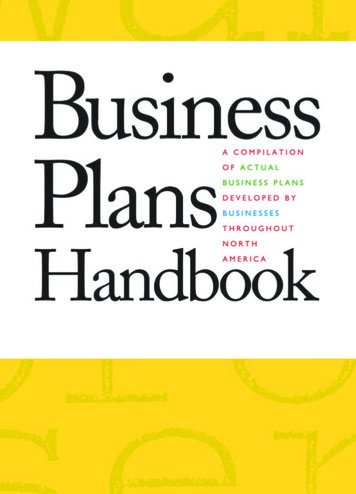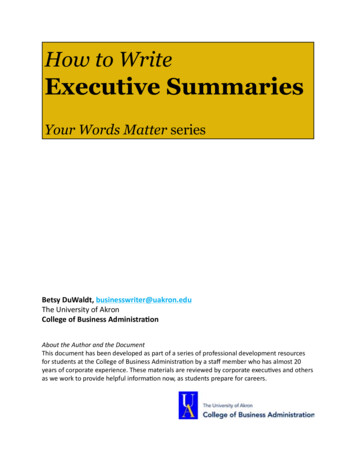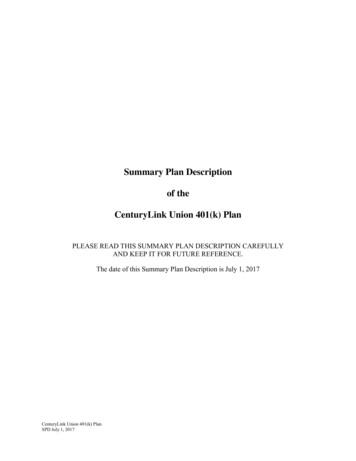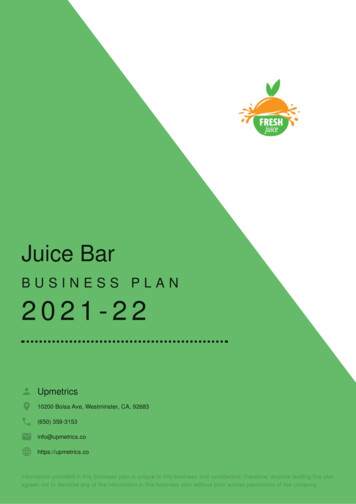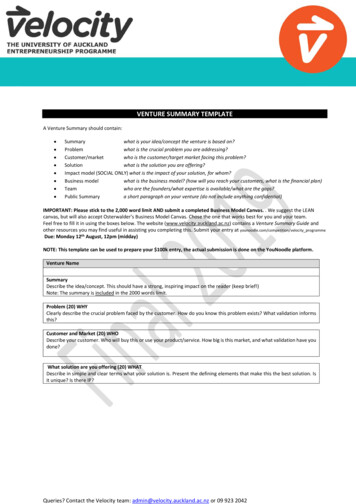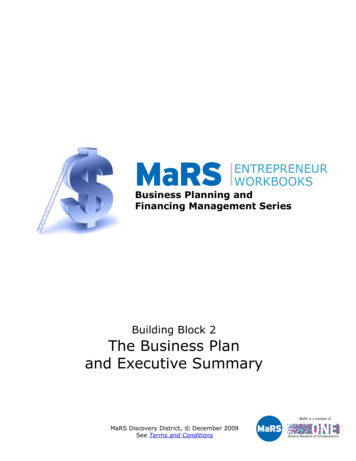
Transcription
ENTREPRENEURWORKBOOKSBusiness Planning andFinancing Management SeriesBuilding Block 2The Business Planand Executive SummaryMaRS is a member ofMaRS Discovery District, December 2009See Terms and Conditions
MaRS – Business Planning and Financing Management Series THE BUSINESS PLANNING AND FINANCINGMANAGEMENT WORKBOOKIntroduction: What to expectIn his book Outliers, Canadian author Malcolm Gladwell looks at the relationshipbetween statistical probabilities and the chance of success in your chosen field ofwork or sports. His essential claim is that you need around 10,000 hours of practiceto become really good in a particular field.This workbook guide will not take 10,000 hours to complete, so you shouldnot expect that you will become an expert in business planning and financingmanagement by going through the activities outlined within. Rather, the purposeof the workbook guide is to help you understand and focus on the key issues inthe field of business planning and financing management, and to introduce you toframeworks within which to think and discuss essential areas of your business. Theprocess offered will provide sufficient grounding in the topic so that you will knowwhat questions to ask advisors and consultants, and, in the case of consultants, howto evaluate their work.Additionally, this workbook guide provides a launch point for a number of vitalbusiness decisions you will have to make to develop your start-up. As a best practice,it is critical to return to these workbooks and revisit facts and assumptions on acontinuous basis. This will ensure not only that you build on your learning experiencebut that you adjust your assumptions to maintain the right course for your business.Building Block 2: The Business Plan andExecutive SummaryThis workbook guide is part two of four covering business planning and financingmanagement. It is designed specifically for entrepreneurs in the high-tech space.The business planning and financing management process consists of four majorparts, or “Building Blocks,” each adding to the foundation of the previous one:Building Block 1: Developing a Financing Strategy for Your CompanyBuilding Block 2:The Business Plan and Executive SummaryBuilding Block 3: Identifying, Targeting and Engaging Potential InvestorsBuilding Block 4: Developing and Delivering a Winning Investor PresentationEach of these building blocks addresses an essential part of business planning andfinancing management. Once you have finished all four workbook guides, you willhave a complete business planning and financing management strategy for yourcompany.With this document in hand, you will be ready to develop the tools you need to raisemoney to grow your business. These workbook guides have been designed so thatyou can adapt the curriculum to your company’s specific needs.Building Block 2 – The Business Plan and Executive Summary
MaRS – Business Planning and Financing Management Series How to use this workbook guide1. Make it a team exercise—but make it quick.Pulling the background information and strategy together to create a coherentbusiness plan can be very time-consuming, especially if you have a fair bit of dataand information to distill. But it does not have to be. We believe that much of theinformation you need is already known to your management team and advisors, sowe recommend that you make the creation of your business planning and financingmanagement strategy a team effort. However, time is of the essence for high-techstart-ups. Work through the building blocks thoroughly, but as efficiently as possible.2. Complete the process.Work through all the building blocks in the business planning and financingmanagement series. The other workbook guides contain useful information forcompleting this workbook guide. Take the time to think through your entries. Talkto advisors and fellow entrepreneurs, and ensure that your business planning andfinancing management documents are integrated and consistent. Your documentsshould contain the most up-to-date information about your business opportunity.3. Use the icons for help.The workbook guides are structured under the assumption that this is the first timeyou, the reader, has undertaken a business planning and financing managementexercise. To help provide context for some of the ideas in these workbook guides, wehave clarified the ideas by defining key terms and offering real-world examples. Inaddition, we have provided links to online articles. For this reason, you may find iteasiest to use these workbook guides on a computer with an Internet connection.Look for these icons:denotes a key business term that will recur in these workbook guidesindicates an example drawn from a real-world business in order toillustrate an important ideadenotes a link to a more in-depth online article, video or templateappears wherever you are asked to record something while completingthe exerciseindicates key information for your business plan, pitch deck or otherdocument you might be preparing for potential external investorsBuilding Block 2 – The Business Plan and Executive Summary
MaRS – Business Planning and Financing Management SeriesBefore You StartThese workbook guides are designed to assist entrepreneurs and their leadershipteams in early-stage technology and life-sciences companies, and are based ontried-and-tested business planning and financing concepts relevant for start-ups in awide range of industries. The following chart outlines for you the curriculum and theprogression of each building block.Building Blocks of Business Planningand Financing ManagementBuilding Block 1:Financing StrategyExecution plan and tasklistFinancing strategyroadmapFinancial planBuilding Block 2:Business Plan and Executive SummaryExecutive summaryBusiness planBuilding Block 3:Identifying, Targeting & Engaging with Potential InvestorsDeveloping a target listElevator pitchBuilding Block 4:Investor PresentationDeveloping an investor presentationPresentation essentialsBuilding Block 2 – The Business Plan and Executive Summary
MaRS – Business Planning and Financing Management SeriesBUILDING BLOCK 2:The Business Plan and Executive SummaryYou will need to develop several investor communication documents or tools whenraising money and interfacing with potential investors:1.2.3.4.The elevator pitchThe executive summaryThe investor presentation or “pitch deck”The business planThese documents or tools will be used at various stages of the fundraising processto convey the appropriate amount of information at the correct time. The process iscomparable to peeling back an onion—you will share more detailed and confidentialinformation with the potential investor as you progress through the investmentevaluation or due diligence process.The process begins with delivering an elevator pitch and providing an executivesummary to explain what your company is about. Investors will consider theinformation (and how you deliver it) to determine if they will continue the processwith you. Using their investment criteria, and based on the matching process, theywill either decline the opportunity or invite you to make a presentation. The firstinvestor meeting is your opportunity to make the investment presentation. You canprovide the business plan at the same time or later in the process.Learn more about the tools you’ll need to raise money.Developing and writing a compelling business plan may seem like an enormous taskthat will require a large time commitment from the management team. However,this workbook guide provides a framework to help you organize and articulate yourthoughts. You may be writing a business plan to provide a strong business casefor an investor to put time and money into your company. A business plan aimedat attracting investors must prove to the potential investors that the team and theassets committed to the business have the potential to achieve sustainable marketpower in a market large enough to justify the investment.Learn more about what investors look for in technology investment.Building Block 2 – The Business Plan and Executive Summary
MaRS – Business Planning and Financing Management Series Why Write a Business Plan?A business plan enables you to demonstrate to stakeholders, including founders andinvestors, that there is potential for considerable growth in a large market. It shouldillustrate that your company is capable of achieving significant market power with asustainable and differentiated product or service offering.The business plan also demonstrates that the opportunity is a good investment deal.It should include value-enhancing milestones and a realistic valuation that will enableinvestors to achieve their target return on investment. The plan should also outline aclear exit strategy.The exercise of developing and writing a business plan provides the entrepreneurialteam with the opportunity to organize your collective insights about the companyand, the business opportunity, as well as how you plan to achieve your objectives.The business plan is the product, but the planning process is more important.Planning, tracking, reviewing and setting goals, and executing on the plan, are thefoundation of running your business.We suggest that you follow this process:Gather theInformationTeam BusinessPlanning WorkshopWrite theBusiness PlanA great way to approach the task is to gather all existing information (either fromavailable documents or other workbook guides in this series) and go through a gapanalysis to establish what information is missing.Remember that investors are evaluating you during their interactions with you aspart of the fundraising process. They want to ensure that you are a trustworthypartner for the long term. Your business plan should be professional, concise andaccurate. The document should be about 25 pages. Have one person draft thewritten document to ensure a consistent writing style. Then have several keyadvisors review the document and provide comments.Building Block 2 – The Business Plan and Executive Summary
MaRS – Business Planning and Financing Management Series 1. Gather All of the InformationThe first step is to determine what information you have and what information youneed to pull together. The following list includes most of the information you willneed to create a business plan: Entrepreneur Series workbook guides (Market Strategy Development, HRManagement, Sales, IP, and Business Planning and Financing Management)mission statement or positioning statementother previously created sections of the business planindustry market research reportsmarket size, penetration strategy and goals (from Marketing workbook guide)price information for products and/or servicesresearch on competitors (from Market Strategy Development workbookguides)copies of patent documentslist of clients including nature of engagementlist of strategic partnerslogo (hard copy and electronic)capitalization tablefinancing to date by principals and investorsfinancial modeltechnology white papersnames and biographies of key employees and positionsnames of service providers (including legal counsel, IP counsel andaccountants)names and biographies of directors and advisorsAssign several key employees the task of gathering the information. The processmay take several weeks. The workbook template includes a checklist.2. Team Business Planning WorkshopAlthough one person should write the document, the management team should thinkthrough and strategize the various components of the business plan. Hold a halfday to one-day workshop to brainstorm and pull together the various sections of thebusiness plan. Consider holding the session offsite so that the group is not distractedby day-to-day work-related issues.Read more about the business plan.Building Block 2 – The Business Plan and Executive Summary
MaRS – Business Planning and Financing Management Series Read more about the business plan template.3. Writing the Business PlanAfter the group-planning workshop, the person leading the writing of the plan shouldhave all of the required information to pull together a compelling document. Ideally,the CEO of the company should write the business plan.The business plan should describe the specifics of your company’s operations and sellpotential investors on your business. Investors see many plans each week so thinkabout how you can make your business plan stand out.Follow these guidelines when writing your business plan: Print the following information at the top or bottom of every page:o date of current version of business plano the statement “Draft: For discussion purposes only”o the words “Company confidential” Write concise and specific sentences and paragraphs. Highlight important points using bold or italic type. Break up the text with bulleted lists, tables, charts and bulleted lists. Add images and colour where appropriate. Include sales and marketing literature with the document. Insert customer testimonials. Provide newspaper and trade journal articles or reviews of your technologyproducts or services.There are many templates available to help you draft your plan. The followingoutline is appropriate for early-stage high-tech companies.Building Block 2 – The Business Plan and Executive Summary
MaRS – Business Planning and Financing Management Series Example: Business plan outlinea.b.c.d.e.f.g.h.i.j.k.Executive summaryProblem definitionSolutionBusiness modelProduct and technologyMarketing and salesExternal environment and competitionManagement teamFinancial projections and key metricsCurrent status, use of proceeds and milestonesRisk analysisa. Executive summaryWhile the executive summary is the opening section in your business plan, draft theother sections of the business plan first, and then write your executive summary.This approach will allow you to be thorough and distill your company’s key strengths.For this reason, details and activities for developing an executive summary arelocated at the end of this workbook guide.b. Problem definitionThe goal of this section is to get potential investors excited about your product orservice. You must convince investors that there is a problem in the marketplace thatis not being addressed by currently available solutions. The key message to convey ishow your company will achieve and sustain market power. Ensure that the investorsunderstand why the problem is important, as well as the customers and their needs.Consider the following questions when writing this section: What is the market your product or service will address?Is there a particular niche in the market that you should focus on first?What problem does your product or service address?How should you price your product or service?Who are the potential customers? What is their profile?How will you get the product or service to your customer?Building Block 2 – The Business Plan and Executive Summary
MaRS – Business Planning and Financing Management Series10The workbook template includes the following headings:Market Overview: Provide an overall description of the market you are in or areplanning to enter.Market Background: Provide the context for your market, including market size,market growth rates, demographics, psychographics, needs and trends, buyingpatterns, preferences and barriers to entry. Use third-party data to support yourclaims.Learn more about market research techniques.Market Challenges: Based on the data, provide the relevant analysis for yourproduct or service, and focus on some unique issues that can be solved.Market Opportunity: Bring the section together by articulating the opportunityand setting the stage for your product or service. Some people call this the “pain” inthe marketplace. Ensure that the reader understands the problem your company issolving or what need is being fulfilled by your solution.You will have documented this information in Market Strategy DevelopmentWorkbook 1: The Analytical Foundation.Write the problem definition for your venture in the correspondingsection of the Business Planning and Executive Summary workbooktemplate.c. SolutionThe solution is a summary statement that describes your product or service andhow it will solve the problem in the marketplace. Describe the solution from thecustomer’s perspective. It should include the following information: details of your product or service and why it is uniqueany special features and benefits of your product or serviceany related intellectual property (IP) that you own or other barriers to entryfor the competitionRefer to the information you have documented in Market StrategyDevelopment Workbook 2: Critical Value Factors.Building Block 2 – The Business Plan and Executive Summary
MaRS – Business Planning and Financing Management Series11Write the solution for your venture in the corresponding section of theBusiness Planning and Executive Summary workbook template.d. Business modelA business model describes an organization’s value to its customers. It illustrates thecapabilities and resources required to create, market and deliver this value and togenerate profitable, sustainable revenue streams. The business model is importantbecause it describes how you will make money with your venture.Most of the information you require to describe your business model will havebeen developed in Market Strategy Development Workbook 2: Critical ValueFactors and Market Strategy Development Workbook 3: Strategic MarketingApproach.This section should include the following details: how your business model worksthe value propositionthe target marketkey partnershipspricing and positioningthe distribution modelRefer to the information you have documented in Market StrategyDevelopment Workbook 2: Critical Value Factors.Describe your business model in the corresponding section of theBusiness Planning and Executive Summary workbook template. If youhave a diagram or chart that illustrates your business model, record ithere as well.Building Block 2 – The Business Plan and Executive Summary
MaRS – Business Planning and Financing Management Series12e. Product and technologyDescribing your product or service provides potential investors with a sense of its keyattributes and why it is unique. This section delves deeply into the technology. It isoften referred to as the “underlying magic” or “secret sauce” behind your technology.Frame the information from the customer’s perspective. Use more diagrams andcharts in this section rather than text.This section should include the following information: a summary of the planned IP strategyhighlights of the potential barriers to entry for the competitionlicenseskey information from white papers or technology summariesRead more about intellectual property protection.Describe your product and technology in the corresponding section ofthe Business Planning and Executive Summary workbook template.f. Marketing and salesMarket adoption and sales are the true measures of success. Clearly convey yourstrategy and tactics to penetrate the market and drive sales. Potential investorswant to understand your customer awareness and buying stimulus programs fromthe customer’s and salesperson’s perspective. If you are not currently selling yourproduct, explain your product launch plans. Convince the audience that you have aneffective go-to-market strategy that will not break the bank.Building Block 2 – The Business Plan and Executive Summary
MaRS – Business Planning and Financing Management Series13Include the following key points: What is your go-to-market strategy?How will you drive market demand for your product?What is your branding strategy?What is your pricing strategy?What is your marketing communication plan?How will you recruit and build your sales force?What is your distribution plan?Who will be your key partners?What is your customer retention strategy?Who are your largest customers?Refer to the information you have documented in Market StrategyDevelopment Workbook 2: Critical Value Factors and Market StrategyDevelopment Workbook 3: Strategic Marketing Approach.Describe your go-to-market strategy in the corresponding section ofthe Business Planning and Executive Summary workbook template.Use the information from the Market Strategy Development workbookguides that is indicated in the bullet list above.g. External environment and competitionThis section includes an analysis of the external environment. You can include thePolitical, Economic, Social and Technology analyses from the Market StrategyDevelopment Workbook 1: The Analytical Foundation.This part of your business plan also involves a thorough competitive analysis. Providean overview of the key competitors in the space. Include a description of theirproducts, pricing strategies, go-to-market strategies, and any strategic alliances andpartnerships. Articulate the competitive advantage of your business model versus thecompetition.A product comparison matrix visually represents how your product fits into themarket, your product attributes and how it will beat the competition. Use thefollowing example of a competitive matrix as a guide.FeatureFeature 1Feature 2Feature 3 Our CompanyCompetitor #1Competitor #2Building Block 2 – The Business Plan and Executive Summary
MaRS – Business Planning and Financing Management SeriesRefer to the information you have documented in Market StrategyDevelopment Workbook 1: The Analytical Foundation.Describe the external environment and competition in thecorresponding section of the Business Planning and ExecutiveSummary workbook templateInclude your PEST analysis in The Business Plan and ExecutiveSummary workbook template.Complete the competitive matrix included in The Business Plan andExecutive Summary workbook template.h. Management teamThis section demonstrates that you have a capable, ambitious and trustworthymanagement team. You may hear investors say that they have invested in a winningteam, which they have either worked with before or who have had some priorentrepreneurial successes. Investors will often look for a management team with thefollowing attributes: Balance: Depending on the company’s stage of development, themanagement team will contain a mix of technical, sales and marketingexperience. The CEO may be the founder or may be hired later as thecompany gets financing. Domain knowledge: Assure the investors that you know your domain deeplyat a macro- and at a micro-level. Experience: The management team’s biographies and CVs should highlightthe relevance of their backgrounds to the venture. Ambition: Demonstrate that you are aligned with the goal of capital gains.Investors want to see a business that has the potential to scale and that youare prepared to do what is necessary to accomplish this goal.To read more about how to write great bios for the executive team, see therelevant section in HR Management Workbook 1: Building an A-Team.Investors also want to understand how you will ramp up your company as you growand take on financing. Consider including a section that summarizes the key hiresBuilding Block 2 – The Business Plan and Executive Summary14
MaRS – Business Planning and Financing Management Seriesover the next 12 to 18 months. The Hiring Calendar in HR Management BuildingBlock 1 is a great supporting tool for this section.Write an introductory paragraph for each management team memberthat captures the key points discussed in the corresponding section ofthe Business Planning and Executive Summary workbook template.Include biographies and CVs in the appendices to the business plan.i. Financial projections and key metricsCost, revenue and cash flow projections will determine the amount of fundingrequired. Describe plausible, value-enhancing stepping stones and tie them to thesales plan. The business plan should drive the budget, not the other way around.Your goal is to describe the growth rate of your business, how long it will take toreach break-even and profitability, resources required to get there, and your fundingrequirements to achieve your plan. Ideally, you can provide two sales scenariosbased on a high and low case to show the sensitivity and range for your plan.Have your accounting professional prepare your income statement,balance sheet and cash flow. Include them in the correspondingsection of the Business Planning and Executive Summary workbooktemplate.j. Current status, use of proceeds and milestonesIn this section, describe how much money you need, what you will do with the funds,how long the money will last and what value-enhancing milestone the funds provide.If this funding does not provide you cash to profitability, then ensure that theinvestors understand what value will be created in the company so that you can raiseadditional financing at a higher valuation.Building Block 2 – The Business Plan and Executive Summary15
MaRS – Business Planning and Financing Management SeriesList your accomplishments, detailed information about how you have financed yourorganization, the amount of money you would like to raise and how you plan touse the investors’ cash. This is your implementation roadmap. You can provide thisinformation using the following table format.Table 1: Sources of FundingSource of fundingExisting financing ( amount)Projected financing ( amount)Investment by principalsEquity investments byangel investorsEquity investments by VCsDebt financingCash flow from operationsTotal fundsTable 2: Use of ProceedsUse of Proceeds AmountSales and marketingResearch and developmentRecruiting costs and salaries of new hiresEquipmentCapital expenses (e.g., office build-out)Legal and accountingTotal usesThese should align with the financial statements that you have included in theprevious section.Provide investors with the milestones you plan to achieve with the funding and howthese milestones will increase the company’s value. A timeline is a useful visualrepresentation that details the milestones you will achieve and the funding requiredto reach those milestones. Consider the following example:Building Block 2 – The Business Plan and Executive Summary16
MaRS – Business Planning and Financing Management SeriesStepping Stone 1Q1 2010EarlyProduct- 5 engineers- Beta product- Commercial CEOSeed Financing 3MStepping Stone 2Q1 2011Seed theMarket- 2 Partners- First release- Early revenues- Build out teamSeries A Financing 4M17Stepping Stone 3Q3 2012MarketPenetration- Proven sales economics- Market rollout- International locationSeries B Financing 5MStepping Stone 4Q1 2014Trade Sale- Market size xM- Break even- 4-6 potential buyersSeries C Financing 8MRecord the information for your company in the table provided in theBusiness Plan and Executive Summary workbook template.You will have created a timeline chart as directed in section 4 ofBusiness Planning and Financing Management Workbook 1: Developinga Financing Strategy for Your Company. Retrieve the chart fromthe Finance Workbook 1 workbook template and include it in thecorresponding section of the Business Plan and Executive Summaryworkbook template.k. Risk analysisSeasoned entrepreneurs and investors know that things rarely unfold as planned.Investors want to understand the risks, and that you have thought about those risksand have a plan to address them should they occur.Think about the critical success factors for the business. Critical success factors(CSFs) are statements that identify what must be done to overcome challenges ormaximize the opportunities identified in the business plan. The CSFs should answerthe question, “What must we do to be successful?” List three to four CSFs for yourbusiness.Use a simple table that outlines the key risks that could detract the business fromachieving the plan. Think about the five to ten key risks to the business and whatyou will do to mitigate each risk.Building Block 2 – The Business Plan and Executive Summary
MaRS – Business Planning and Financing Management SeriesType of RiskRiskMitigating StrategyProduct RiskThe product won’t workWe have a backup productMarket Adoption RiskThe customers won’t buy itWe have completedmarket research toposition the productMarket Size RiskThe market is smaller thanwe estimatedWe have identifiedadditional markets forfuture growthCompetitive RiskThe competition maylower their price to protectmarket shareWe have built in enoughvalue to command apremium priceFinancing RiskWe may not be able tosufficiently finance thecompanyWe have developedalternate financingscenarios to ensurethat we meet the keymilestonesExecution RiskThis is the first earlystage venture for themanagement team.We have supplementedour team with industryleading advisorsRecord the critical success factors (CSFs) for your business in thecorresponding section of the Business Plan and Executive Summaryworkbook template.Complete the risk template that is included in the Business Plan andExecutive Summary workbook template.Building Block 2 – The Business Plan and Executive Summary18
MaRS – Business Planning and Financing Management SeriesWriting the Executive SummaryThe executive summary is a standalone document that is often provided first to apotential investor.The goal of the executive summary is to get potential investors sufficiently interestedin your business opportunity to dig further into your business plan or take a meetingand hear your presentation. Investors see many opportunities so your executivesummary must stand out in the first few sentences.Think of the executive summary as your business plan in two pages. We haveadapted the following outline from Guy Kawasaki’s Reality Check. The headings coverthe components that should be included in the executive summary.Example: Executive summary outline Problem: What pressing and important problem are you solving orwhat opportunity are you addressing? Solution: How are you solving this problem or tapping thisopportunity? Business mo
Building Block 2 – The Business Plan and Executive Summary How to use this workbook guide 1. Make it a team exercise—but make it quick. Pulling the background information and strategy together to create a coherent business plan can be very time-consuming, especially i




